50 Art Ideas in an Art Journal
This week I have a special treat for you: a flip-through video of my full Dylusions Creative Journal. It has 50 art ideas, not only for art journaling but for art-making in general.
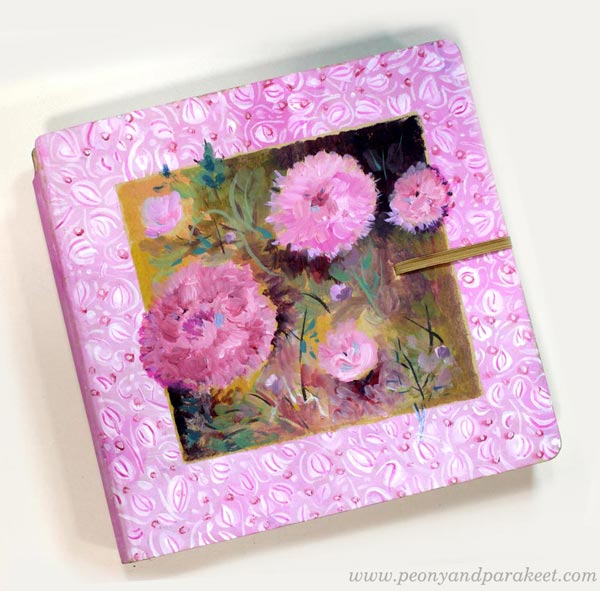
The pages are mostly made with colored pencils, watercolors, and acrylic paints. I also have many that have hand-drawn collage pieces.
I started the journal in 2020 and finally finished it now in 2025. There are so many memories saved in it. But I didn’t want the nostalgy to take over, but tried to make the video as useful and as easy to watch as possible.
50 Art Ideas – Watch Now!
There’s so much ideas that I thought it would be handy for you to have all the ideas and links listed.
List of Art Ideas and Links to Related Content
#1 Borders
Get inspiration from books and paint covers so that they have borders.
#2 Draw a Tassel!
Draw a decorative object like a tassel rather than an animal or a person.
Blog post: Making the Art Journal More Magical
Course: Animal Inkdom
Course: Magical Inkdom
#3 Forgotten Supplies
Check what supplies you have and use those that you haven’t used for a very long time. At the same time you can decide if you really want to keep them.
Blog post: Art Supplies I Should Not Use Anymore
#4 Introduce Yourself!
Tell who you are in words and pictures.
#5 Title
Give the book a title that inspires you.
Blog post: Adding Text and Layers to Your Pages
#6 Makeover
Paint over any page so that the previous layers show through. Then add details on top of everything.
#7 Alice in Worderland
Paint a place where strange things happen.
Blog post: Painting a Mystery
Blog post: Wonderland Art – Inspiration from Alice in Wonderland
#8 Indoors and Outdoors
Paint a room with large, open windows. Imagine that the outside world floods in.
Blog post: Painting a Mystery
#9 Cafe Bakery
Imagine a lovely cafe where you bake cakes.
Course: Decodashery
#10 Paint with Pencils
Use colored pencils like they are paints and color without outlines.
Course: Intuitive Coloring
#11 Child’s Drawing
Use a child’s drawing as a starting point for a page.
#12 Hole
Make a window from one page to another by cutting a hole.
#13 Scribbles
Pick a black pen and scribble and doodle your heart out. Then use the drawing as a coloring page.
Blog Post: Don’t Just Create Circles
Blog Post: Doodler’s Sampler Step by Step
#14 Transparency
Draw on a transparent film or print your drawing on the film.
Blog post: Creating Wood by Doodling Layers
#15 Safari
Draw animals and use unconventional colors and details.
Course: Animal Inkdom
#16 Time Travel
Combine your art from several years into one spread.
#17 Happy
Collect happy things and write comforting and hopeful thoughts.
Blog post: Mini Drawings on Art Journal Pages
#18 Inner Child
By creating, we cherish our inner child. Let her face appear in one of your pages.
Blog post: Coloring with the Inner Child
#19 Columns
Add drawings and paintings as vertical stripes on the spread.
#20 Free Video: Colored Pencils – Intuitive Approach
Blog post: Colored Pencils – Intuitive Approach
#21 Underwater
Let blue tones dominate the background and create an underwater scenery.
#22 Nighttime
Imagine what can happen in the night when no one is watching.
#23 Fairytale
Make up a fairy tale while you draw.
Blog post: Picture Prompts – Creating Art Journal Pages with Handdrawn Animals
Course: Animal Inkdom
#24 Wings
You can draw wings on almost anything.
Blog post: Picture Prompts – Creating Art Journal Pages with Handdrawn Animals
Blog post: Angel Drawing for the Inner Child
Course: Magical Inkdom
#25 Four Seasons
Express spring, summer, fall, and winter in one spread.
#26 Seed Flower
Start with a single flower.
Blog post: Flower for Your Art Journal
Blog post: Expressive Watercolor Flower Collage
#27 Floralize!
Leave some happy parts of bad art visible and then paint flowers on the top.
More ideas for revamping:
Blog post: Revamp Art Journal Pages So That They Spark Joy!
Blog post: Revamping Watercolor Painting with Watercolor Pencils
Blog post: Art Makeover – Revamp Your Old Paintings!
#28 Carve & Stamp!
Carve a lino plate and use it as a stamp.
You can also use a gelli plate.
Blog post: Gelli Plate Meets Fine Art – Monoprinting Ideas for Art Lovers
#29 Lemons
Express your appreciation for lemons or other fruits by painting or drawing them.
Blog post: Painting And Drawing Fruits
Course: Fun Botanicum
#30 Vermeer Girl
Re-create the face from Johannes Vermeer’s painting Girl with Pearl Earring.
Blog post: Vermeer Girl with Heart – Draw with Me!
#31 Glow
Make a drawing that glows without using any glitter. Use soft transitions from light to dark.
Blog post: Bringing Old-World Feel to Abstract Painting
#32 Spirit
Visualize the person’s spirit, not only the face.
Blog post: Intuitive Art Journaling
Blog post: Coloring an Intuitive Selfie
#33 Puzzle
Glue a couple of small drawings on the page and continue their outlines so that they form a new image.
Blog post: Mini Drawings on Art Journal Pages
#34 Easy Start
Paint the background with watercolors and then use it as an inspiration for coloring.
Blog post: Why Draw in the Ready-Made World?
#35 Stripes
Paint stripes of your current favorite colors.
#36 Scan, Print, Collage!
Scan your drawings and print them smaller. Use the printed images for a fun collage with stripes.
Blog post: Making the Art Journal More Magical
Course: Magical Inkdom
#37 Block
Paint rectangles and triangles to make a design.
Blog post: Building and Breaking – Revealing Artistic Potential
Blog post: Art Quilts in a Modern Way
About Paul Klee
Blog post: Paul Klee and the Art of Learning
Course: Floral Freedom
#38 Chapter
Make a themed chapter of several pages for your art journal.
Course: Hearts and Stories
Course: Fun Botanicum
#39 Storybook
Make a storybook page.
Blog Post: Art Journal as a Storybook
#40 Childhood Memories
Get inspired by your childhood and draw things you loved back then.
Blog post: Maximalist or Minimalist? Style Experiments in Art Journal Pages
Blog post: Choosing the Word for 2025
#41 Dolls
Rather than drawing a realistic person, design a doll with all the accessories.
Course: Decodashery
Course: Doll World
#42 Dark Background
Make an impact with the contrast between bright flowers and dark background color.
Blog post: Imagining Flower’s Spirit
#43 From Back to Front
Add more than one color to the background and, at the same time, adjust the shape of the foreground objects.
Course: Freely Grown
Course Wild Garden
#44 Modern
Make organic shapes more angular and thus more abstract and modern.
Blog post: Making Florals More Modern
#45 Letters
Imagine that the letters are fictional characters and add expression and decorations to them.
Blog post: Making the Art Journal More Magical
Blog post: Draw Your Own Fonts
#46 Watercolor Love
Paint flowers with watercolors.
Course: Wild Garden
Course: Freely Grown
#47 Castle
Imagine a building that is full of fun details.
Blog post: Intuitive Art Journaling
#48 Experience
Imagine being in an imaginary place.
Blog post: Intuitive Art Journaling
#49 More Is More
Be a maximalist, and get inspired by nature’s abundance.
Blog post: Maximalist or Minimalist? Style Experiments in Art Journal Pages
Blog post: Following the Inner Color
#50 Jewelbox
Divide the page into small compartments and color the compartments one by one.
Need More Than These 50 Art Ideas?
See the blog post from 2020: 75 Ideas in an Art Journal
I hope you enjoyed this post and put the art ideas in use. Let’s keep creating!
Making Florals More Modern
This week, we are making florals more modern! So, when you want to get away from a botanical look, and draw and paint flowers that are more abstract and expressive, here are my tips for you!
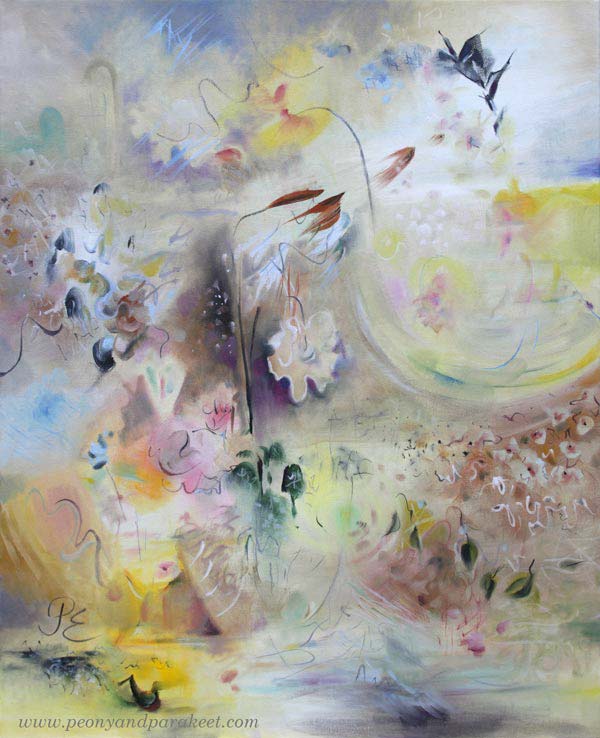
In my recent painting Gossamer, I have stretched my style to a modern direction. The painting was born much faster than usually if you count the actual painting time only. But that’s not the whole truth because I practiced this style several times. You too, can make your florals more modern in this way!
#1 Choose Your Muse!
Pick a painter that has a modern abstract style for flowers.
My choice was Helene Schjerbeck (1862-1946). She was a famous Finnish modernist, and even if I find many of her paintings a bit too melancholic, her style fascinates me.
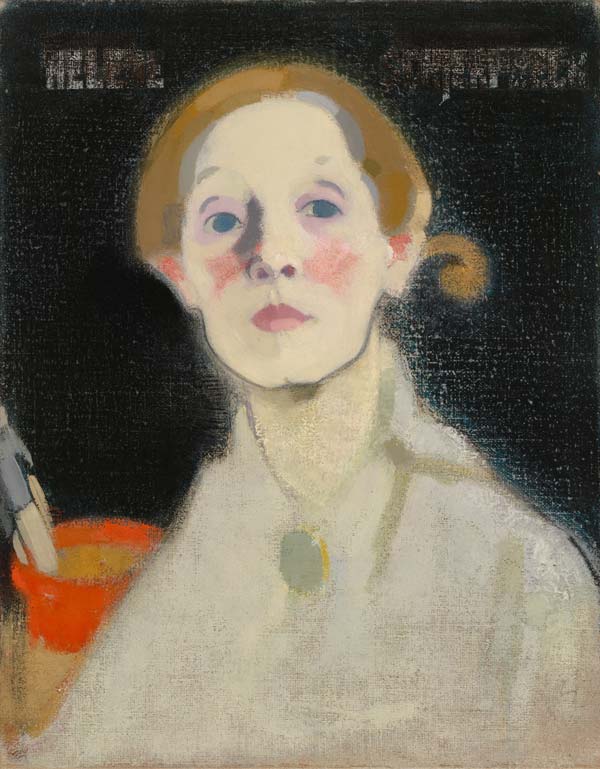
Helene is more of a portrait painter, but she also painted many still lives. (By the way – I also have a blog post about mimicking Helene Schjerfbeck’s style in portraits in colored pencil.)
#2 Make Many Tiny Sketches on One Page
Paint or draw small sketches where you pick ideas from your muse’s paintings. Combine many paintings on one page. When the size is small, you need to simplify and thus, find the core of your muse’s modern style.

I examined several Helene Schjerfbeck’s paintings in watercolor and combined them on one art journal page.
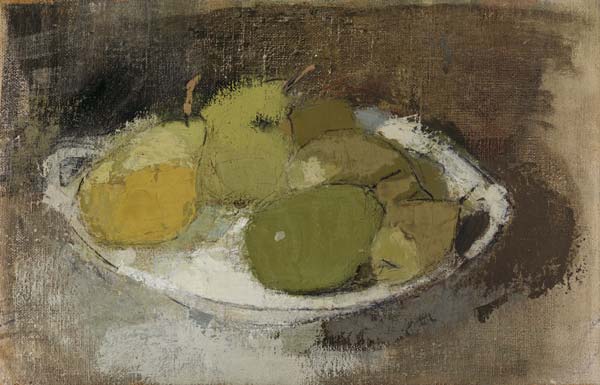
Focus on the shapes and lines and answer to these questions while working:
- Are the muse’s shapes light or heavy?
- How angular are the single strokes?
- How light and shadows are expressed?
- Where can you find playfulness and creativity?
Helene Schjerfbeck’s shapes are rather heavy, and her strokes are quite angular. The light and shadows are treated like they are objects as well. The result is a puzzle where the material and immaterial are treated identically.
I didn’t first think that Helene’s paintings are playful, but when I browsed more of her paintings, I started to see humor in the way she painted the shadows. There is something human in their shapes. It is shown brilliantly in this piece “Trees and Sunset.”
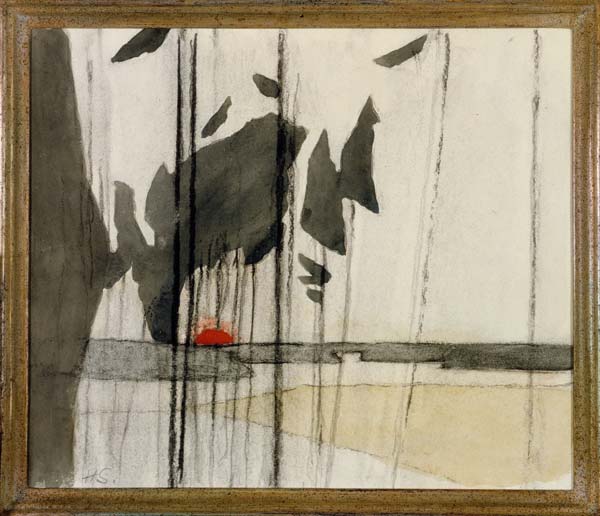
I started to think that maybe for my muse, the shadows were like animals, or dolls, and that they could be a little like toys in my paintings too.
#3 Create a Bigger Study More Freely
Next, use your observations to create a bigger study. Work freely and mix the observations with your original style.

I used left-over oil paints and made this spread for my Dylusions Creative Journal. I really like how playful the shadows are, and painting this was a lot of fun!
In the detail pic below, you see how angular my strokes are.
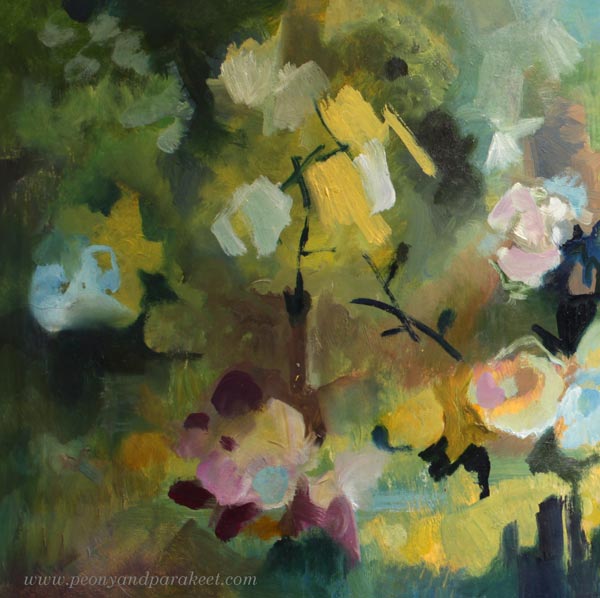
When searching for images for this blog post, I found this small painting from Helene Schjerfbeck. My flowers are different, but still there are similarities as well.

My best tips for making florals more modern:
- While working, think about surface patterns in interiors and clothing rather than the actual flowers.
- Use angular strokes to build puzzle-like compositions.
- Similarly to the parts of the colorful flowers, see the shadows and light as the shapes of the puzzle.
#4 Make the More Modern Piece
After practicing, you can now create a piece where you spend more time for finishing. Modern strokes often appear quick and careless, but they are still packed with aesthetics and style. Those kind of strokes can take a lot of attention and focus.
Here’s a pic from the early stage of my painting Gossamer. I started with a narrow color scheme, and many of the shapes and strokes were more like suggestions – a whispering start, you could say!
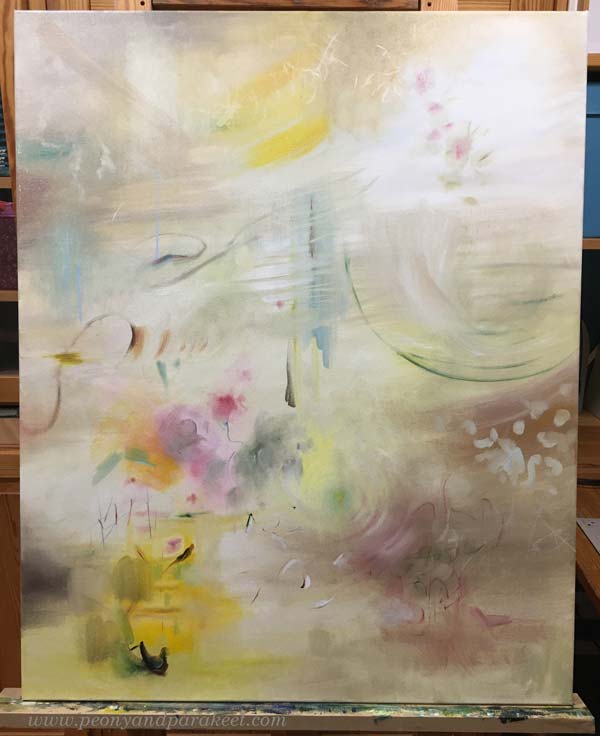
In the finished piece, I especially enjoy the playful color changes in the background and the new playfulness is present in lines too.

#5 Old and New – Compare!
Here you can see my previous painting of the same size and the finished Gossamer side by side. The styles of the two paintings are slightly different, but not totally!
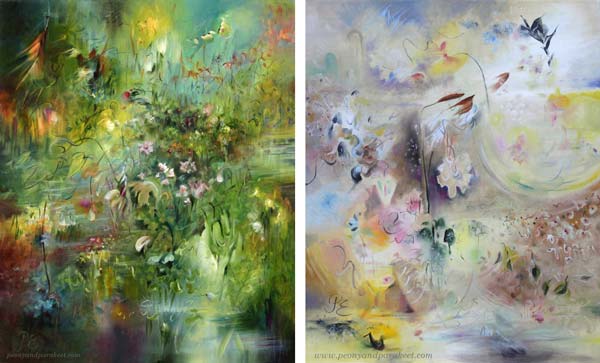
I used leftover paints for these two miniature paintings. The one on the left is more of my original style, the other one is more modern.
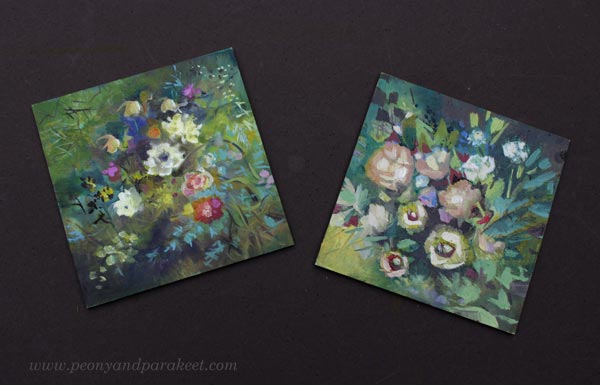
If the weather allows, I always take the photo of the final piece outdoors. This fall has been exceptionally long and warm. There are still leaves in the apple tree, and it’s November!
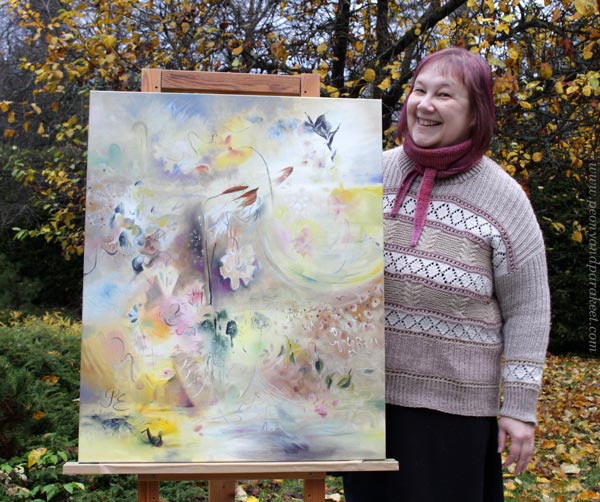
I hope you enjoyed this little tutorial on how to make florals more modern!
Intuitive Art Journaling
Art is more than re-coloring what we already see. This week, I talk about intuitive art journaling and inspire you to follow your spirit and create more freely.
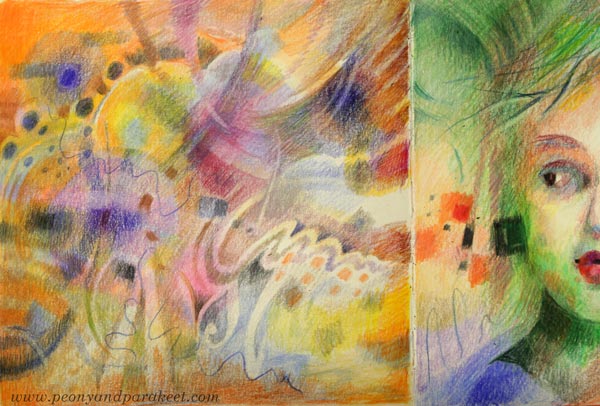
Even if we continuously grow our skills as artists, the joy of art-making disappears if we use too much reasoning. It’s good to practice the technical skills, but it’s also important to arrange time for the intuitive ideas to emerge.
Two Words – “Intuitive Power”
“Intuitive power” – these words suddenly came to mind when I looked at my colored pencils recently. I have been painting a lot, and it has made me miss my colored pencils, those powerful helpers! So, while working on the last pages of my Dylusions Creative Journal, I have been spending some quality time with them.
I started with a house, but then moved on to color more freely. I wanted to catch the atmosphere of that place rather than stay in the material level, drawing windows and such.
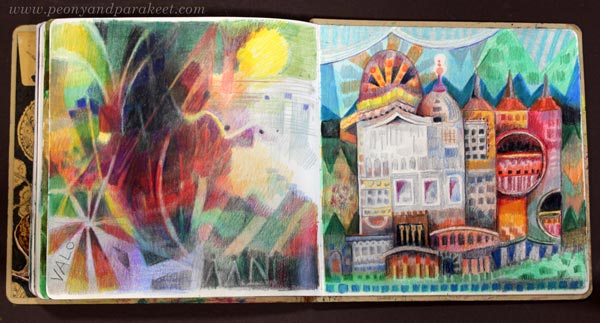
The longer I have been an artist, the more I have wanted to work with invisible things. More than tangible things, I want to express the spirit and the complexity of the world that can’t be photographed. I want to create images that are more like keys to many questions rather than direct answers to one.

Intuitive Artist
Even if I have embraced and used the word “intuitive” for over ten years, I have now realized that it’s not just one word of the many, it’s “the word” for me. And I don’t mean to narrow myself with the word, but to expand my thinking and creating in the direction that feels natural to me.
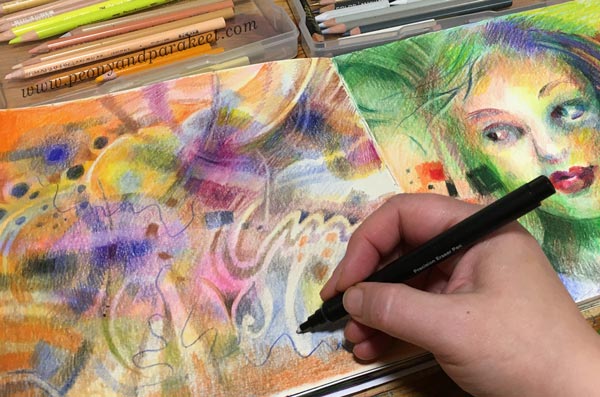
More than a building, I want to visualize the spirit of the place – the sensations that it causes in me.

More than a face, I want to visualize the spirit of the person.


Art Journaling Without Words
Rather than words, intuitive insights can come up as pictures. So, intuitive art journaling can be as simple as creating a series of drawings. The connection with a certain color can be enough to get started.
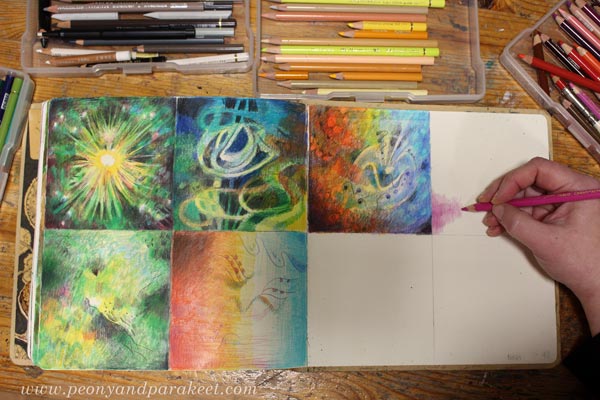
Color is a hole, and if you jump in, you enter the immaterial world. Colored pencils are the easiest tools for breaking the ice between the inner and outer.
“Intuitive power” – what do these words evoke in you?
Making The Art Journal More Magical
I have been working on my square-sized art journal again. This week, I share a couple of magical art journal projects that include hand-drawn collage pieces.
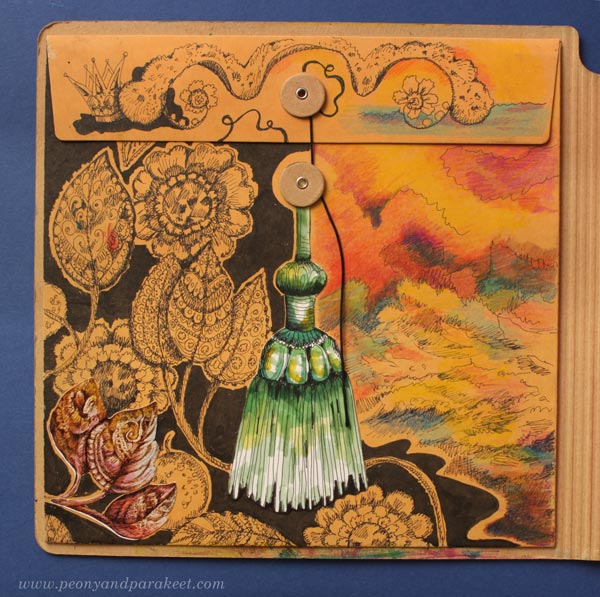
My journal is Dylusions Creative Journal. The first project is the decoration of the pocket envelope that’s on the backside of the front cover.
The Magical Mindset for Art Journaling
My journal is almost full, but I have decided not to hurry with the last pages. Recently, I have started to think that using what I have is better for me. That if I rush with the last pages and buy a new journal, it’s not as good as if I slow down and fully honor those few blank pages. You could call this a magical mindset because it makes you appreciate what you already have: skills, little drawings, time, blank paper.
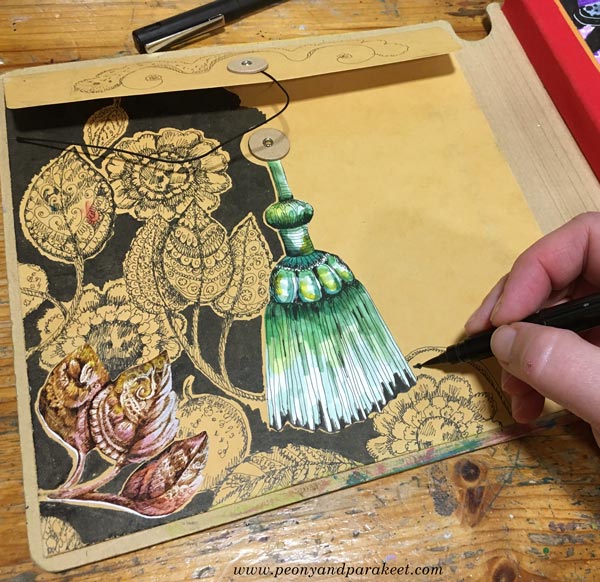
With the magical mindset, you don’t just look forward and think what you could have. Instead, you look back and focus on how you can take the old to the next level.
So, I went to my boxes of joy – the boxes that store my handdrawn collage pieces – and picked a set of leaves from a few years ago and glued it on the envelope. The leaves are a print and smaller than the original drawing. I love some of my handdrawn pieces so much that I have scanned and made prints of them.
I drew some more leaves and then glued the tassel which is an original drawing too. The tassel divides the image in two parts. I drew and colored a seascape on the right side of the tassel.
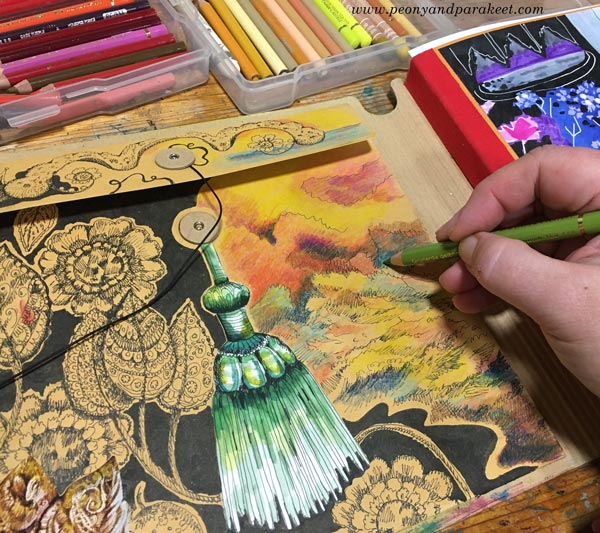
I love the oldfashioned and luxurious look of the envelope now. The inside cover was made earlier with markers.
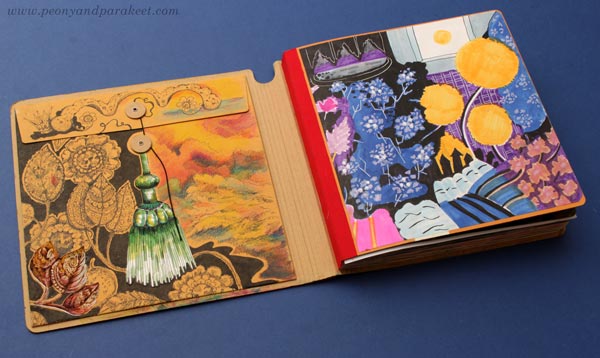
I had two tassels to choose from. I love them both.

Magical Stripes on Art Journal Page
The second project is a page with hand-drawn collage pieces. The idea here is to draw stripes and then decorate them. I made my page so that some of the decorations extend over the stripes.

The teacups, the heads of the cats, monkeys and rabbits are prints made from bigger hand-drawn pieces. The rest is drawn with a black drawing pen and colored with colored pencils.
Here you can see the print sheets that I have made for myself and the original drawings. These are all drawn for the courses Magical Inkdom and Animal Inkdom. I had so much fun making these courses. The details are magical and I think the stripy page became magical too.

The rabbit and the teacup are two separate pieces.

I have randomly created on the pages over the years. The page on the right is painted and very different in style, but I think these are just layers of time. Like home, an art journal can have some old pieces, some newer ones, and some that connect all the years. I started my journal in 2020.

The abstract house could be the place where this magical tea party happens.

Magical Letters
In the previous blog post “Mini Drawings on Art Journal Pages“, I showed a spread that was still in progress. That’s finished now. I think letters on the black background with some leaves and flowers look magical too.
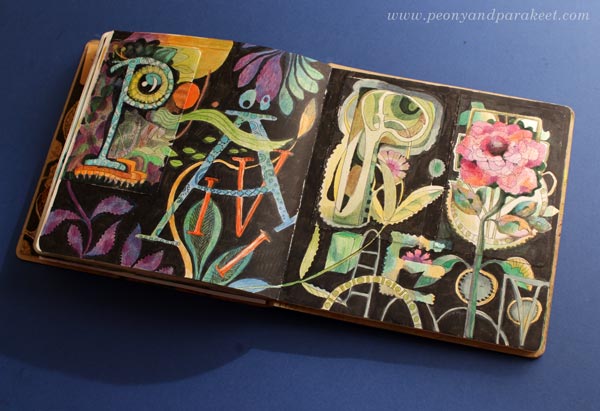
I hope these projects inspired you to make your art journal more magical!